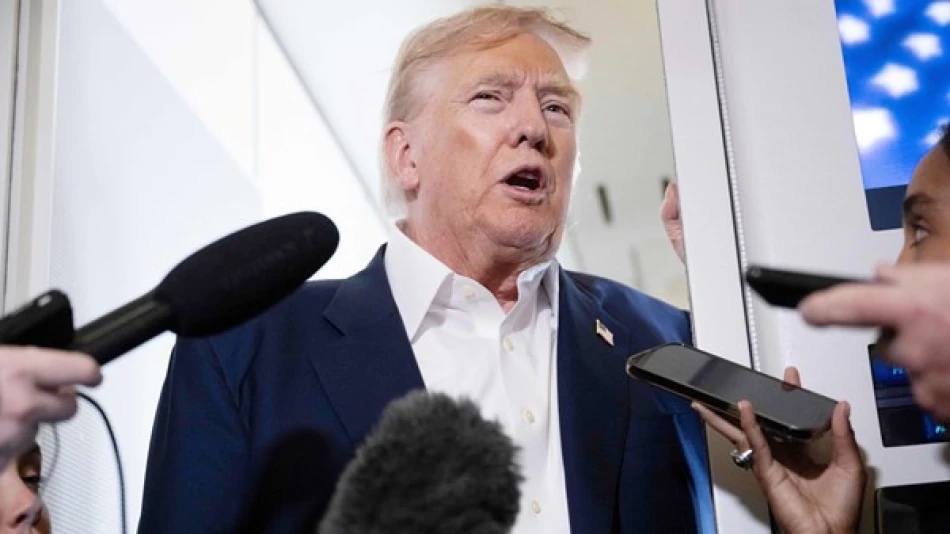
Trump Announces Trade Deal with South Korea, Boosts Economic Ties
Trump Secures Major Trade Victory as South Korea Accepts 15% Tariffs in $450 Billion Deal
President Donald Trump announced a sweeping trade agreement with South Korea that imposes 15% tariffs on Korean goods while exempting American exports from reciprocal duties. The deal includes $350 billion in U.S.-controlled investments and $100 billion in energy purchases, marking a significant shift in trade dynamics between the allies and potentially reshaping global supply chains in automotive and technology sectors.
A Strategic Retreat from Harsher Penalties
The agreement represents a diplomatic victory for Trump, who had previously threatened to impose 25% tariffs on South Korean imports starting August 1st. By securing the 15% rate through negotiation rather than unilateral action, the administration avoided potential retaliation while still achieving substantial concessions from Seoul.
Commerce Secretary Howard Lutnick confirmed that the new tariff structure will specifically target automotive imports, striking at the heart of South Korea's export economy. Companies like Hyundai and Kia, which have built significant market share in the U.S., now face increased costs that could force strategic adjustments in pricing and production locations.
Massive Investment Commitments Reshape Economic Ties
$350 Billion Investment Program
The centerpiece of the agreement involves South Korea committing $350 billion in what Trump described as "American-owned and controlled investments" subject to presidential selection. This structure suggests unprecedented U.S. oversight of Korean capital deployment, potentially covering semiconductor manufacturing, defense technology, and green energy infrastructure.
This investment mechanism mirrors successful models used by Singapore and the UAE, where sovereign wealth funds channel resources into strategic partnerships with major powers. However, the direct presidential involvement in project selection represents a more centralized approach than typically seen in free-market economies.
Energy Security Through Trade
Seoul's commitment to purchase $100 billion worth of liquefied natural gas and other energy products addresses two key American priorities: reducing the trade deficit and expanding LNG export markets. This aligns with broader U.S. efforts to position itself as a reliable energy supplier to allies seeking alternatives to Russian and Middle Eastern sources.
Market Implications and Global Ripple Effects
For investors, this agreement signals a new template for U.S. trade relationships under Trump's return to office. The asymmetrical tariff structure—where Korean goods face duties while American exports remain tariff-free—could pressure other trading partners to accept similar arrangements or risk harsher treatment.
Automotive sector impacts will likely be immediate, with Korean manufacturers potentially accelerating existing plans to relocate production to the United States. This follows the playbook established during Trump's first term, when tariff threats drove significant manufacturing reshoring across multiple industries.
The deal also establishes a precedent for managed trade relationships where specific purchase commitments and investment targets replace traditional free-trade frameworks. This approach, while criticized by trade purists, has proven effective in securing measurable economic benefits for the United States.
Strategic Calculations Behind Seoul's Concessions
South Korea's willingness to accept these terms likely reflects broader geopolitical considerations beyond pure economic calculation. With North Korean tensions persistent and China's economic influence growing, maintaining strong ties with Washington takes precedence over trade optimization.
The agreement also provides South Korean companies with regulatory certainty, replacing the uncertainty of potential 25% tariffs with a predictable 15% rate. For export-dependent conglomerates like Samsung and LG, this clarity enables long-term planning despite the increased costs.
This trade framework represents a fundamental shift toward bilateral economic management that prioritizes strategic outcomes over market efficiency. Whether other allies will accept similar terms—or if this approach proves economically sustainable—will likely determine the future architecture of American trade policy.
 Layla Al Mansoori
Layla Al Mansoori







